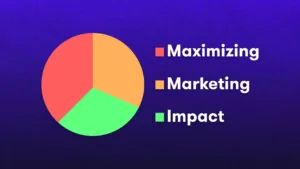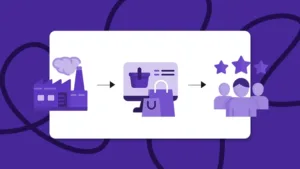Maximizing Marketing Impact: A Exhaustive Guide To Using Instagram Stories Ads

More than 500 million people use Instagram Stories every day. And because of this, it’s one of the most powerful tools for getting your message across to your audience.
But how do you do that effectively?
That’s the topic of this guide. It explores how to create effective ads and the best practices you can use. You will learn how to measure the success of your campaigns and improve performance.
Instagram Stories ads are mini segments of videos or photos that appear between content on users’ Stories feeds. Recently, Instagram introduced a vertical format (similar to TikTok) instead of getting people to navigate with horizontal swipes. Stories are ephemeral (disappearing within 24 hours) but ads continue to display as long as you run your campaign.
The Standout Benefits of Instagram Stories Ads
So, why are Instagram Stories Ads so beneficial? What makes them such a powerful option for your outreach efforts?
Higher Engagement Rates
Instagram Stories ads are effective because of their high engagement rate. Estimates suggest that 1.5% to 6.2% of users feel engaged by them, significantly higher than many other forms of advertising (including conventional Google remarketing).
Higher engagement rates are possible because of Stories’ interactive features, like polls and quizzes. The full-screen ad format also focuses the user’s attention (as they continue swiping), making them more potent than conventional feed ads.
More Reach
Instagram Stories ads also have tremendous reach because of the sheer number of users on the social network. More than half a billion people scroll these stories every day.
Moreover, these users’ wealth is high. Forty-two percent earn more than $75,000 annually in the U.S., making Stories consumers a high-value target market for nearly every brand.
Creative Flexibility
There’s also the creative flexibility Instagram Stories offers. Creators can post ads in various formats including:
- Images
- Short clips
- Images and short clips (a combination of the two)
- Branded content with influencers (that appears native in Stories)
- Carousel ads showing single or multiple ads
Driving engagement with polls, questions, and quizzes, and encouraging users to sign up is also possible. Augmented reality, text effects, and animation (GIF) options make the user experience more engaging and exciting.
Immediacy
Immediacy is another substantial benefit of Instagram Stories. The platform lets you post flash sales and time-sensitive information to users when you want (unlike conventional channels that require more planning). These are ideal for running quick promos and drumming up interest while specific topics are trending.
Measurability
Finally, Instagram offers exceptional measurability. As part of the Meta family of services, you can probe the metrics that matter, including clicks, impressions, and conversions. You can also see saves, comments, reach, total followers, traffic, follower growth, and Story engagement, and evaluate your targeting strategies and campaigns to see what works best with A/B testing.
Creating Compelling Stories Ads That Generate Sales: Proven Formulas And Best Practices
The benefits of Instagram Stories ads are obvious (which is why so many businesses use them). But how do you emulate this success?
That’s what we discuss in this section. You will learn how to generate more sales and make the most of your budget on the platform.
Follow The Design Requirements
Before you start building anything, ensure you follow Instagram Story specs. These ensure your content’s format fits users’ screens and meets acceptable quality standards.
Ideally, all images or videos should be in Full HD: 1080px by 1920px. You can opt for smaller dimensions in the same aspect ratio (down to 600px x 1067px) but they might look blurry or stretched.
Photos should be .jpg or .png while videos should be .mp4 or .mov files. Keep videos under 60 minutes long (and 250 MB) and photos under 30 MB. Instagram supports video codecs H.264 and VP8 and audio codecs AAC and Vorbis.
Don’t Be A Jerk
Next, don’t use the platform to advertise anything that other users might not like or find offensive. Instagram is a family-friendly platform.
Meta – Instagram’s parent company – sets various standards to protect users from harmful content in its guidelines. Most of these are common sense. In general, if you wouldn’t show an ad to your grandma, don’t put it on Instagram.
Banned content includes:
- Anything illegal
- Ads that contain discriminatory language, images, or rhetoric
- Content promoting drugs or the use of other unsafe substances
- Adult content, including phone services
- Adult products
- Polemic content (designed to stir up tensions)
- Ads that link to broken landing pages
- Content that uses poor grammar, spelling (unless for branding), and profanity
- Ads that infringe on third-party intellectual property (such as copying existing ads and placing a link to your site)
- Ads relating to tobacco or the use of tobacco
These restrictions are likely what you expect from a mainstream platform and might be party-poopers for some niche brands. However, most companies can still benefit (even if Meta Platforms are puritanical sometimes). Just remember the sheer reach it offers.
Dial In Your Targeting
You also want to ensure you dial in your targeting, only reaching out to those likely to buy from you. With Instagram Stories, you can target your audiences:
- Basic demographics
- Interests (such as fashion, fitness, and technology)
- Purchase behaviors (including whether they are frequent shoppers or recently made a purchase)
- Travel behaviors (including driving to foreign countries)
- How they use their devices (the make and model or whether they use Android or iOS)
- Lookalike audiences (leads with similar characteristics to the people you want to target)
- Connections on the platform (and number of followers)
You can also target new groups (like friends of followers) and even display ads on a case-by-case basis.
The level of customization is high, so use it wisely. Do thorough audience research to learn who follows your content and what they want to see.
Set Your Budget
The next step is to set your budget: how much you are willing to spend on ads on Instagram Stories. The funds you allocate will depend on your business’s size and objectives.
Hopefully, you already have a budget based on your existing marketing efforts. However, it might be worth considering overweighting into Instagram Stories ads, given their engagement statistics and reach.
You can also experiment to see what works over time. Some brands start small, wait for results, and then ratchet their spending while measuring their return on investment (ROI). This approach lets you take baby steps and reduce the risk of losing money. Plus, you always know your efforts are profitable. You aren’t putting cash upfront and hoping for the best.
However, you can also take a risk and plunge more money into the platform to avoid wasting time. It depends on what works for you.
Use Vertical Full-Screen Format
When shooting an Instagram Stories ad, always take it in portrait mode. That’s the way most users will view it. Don’t use landscape (because it will stretch or have black lines at the top and bottom).
You should consider using fullscreen vertical mode for all the content you create. That includes images, videos, polls, surveys, and questions.
Also, think about the placement of elements like stickers and effects. These should also follow the vertical format style and look you want.
Tell The User What To Do
While creating the visuals, tell the user what you want them to do. Direct them to the next step in the sales or conversion funnel.
Usually, this step will involve placing a link to your landing page. However, it could also mean putting them on a free trial or getting them to answer a question.
You should also accompany the link or instruction with a call-to-action (CTA) – a phrase compelling users to take action. These could include things like:
- Buy tickets
- Start your free trial
- Book your hotel room today
- Tell us what you think
- Place your vote
Ideally, the CTA should clarify what you offer. Users should have no doubt about what to do next.
Make Your Ad Copywriting Compelling
As always, you want your ad copywriting to be compelling on Instagram stories ads. The more engaging and brand-relevant you can make it, the better.
Start by making the writing persuasive. Research shows that it can boost conversion rates by over 16%.
You also want it to be concise. Getting to the point quickly can raise conversion rates by over 27%.
Tailoring the copy to your audience also helps. Using their turn of phrase (instead of industry jargon) can create rapport and encourage them to click further.
While doing this, speak to their desires. Get under their skin to learn what they want from you and how you can deliver it.
For example, you might say:
“Stop spending hours appending data to your databases. Use our automatic AI merge tool for results in seconds.”
Or,
“Tired of endless visits to the barbershop? Use our grooming kit to do it at home.”
When writing in this style, use emotional triggers. Look for phrases or words that will provoke a response from your audience.
The best emotions to target include:
- Urgency – “Shop today for a guaranteed discount”
- Happiness – “Put a smile back on your face with our soothing product collection”
- Fear – “Stop risking your health with low-quality supplements and try out third-party tested options instead”
- Excitement – “Choose our coaching and transform your life from the ground up”
Use Text Overlays
When creating this copy, consider how it will appear as a text overlay. While visuals can be highly effective, writing sometimes says it better.
For example, Hootsuite found that placing text centrally (in the middle of an ad) enhances add-to-cart objectives (buying) by 75% compared to a random placement.
Ensure text overlays fit into the box you define for them. Don’t make them too long or challenging to read. Many brands show a single word at a time for emphasis and easy reading.
Improve Your Audio
Instagram Stories Ads usually have accompanying sounds. However, audio can be a problem for some advertisers.
Aside from fulfilling the technical requirements (discussed earlier), audio should convey your ad’s value.
That means showing leads how listening through it can benefit them. Research shows that adding sound or music to your creations can boost performance by an astonishing 80%. And since Instagram users watch 70% of Stories with sound on, it’s a no-brainer.
Add Social Proof
Also, add social proof to paid Instagram Stories ads where possible. Show how users’ peers are also benefiting from your services.
One option is to go down the pure user-generated content (UGC) route and film customers talking about their positive experiences with your brand. Authentic-looking videos are often all most leads need to give you a try.
You can also overlay text reviews from third parties (along with links to independent review sites). Again, these can profoundly affect users’ willingness to take the next step.
Other clever forms of social proof include:
- Influencer endorsements
- Before and after transformation stories (perhaps after using your services for six months)
- Statistics collected by third-party research firms about the quality of your products
- Brand mentions from high-profile publications like Forbes, the New York Times, or Washington Post
- Quotes from celebrities who mentioned your brand on their social media (preferably with their consent)
If you can fit two or more forms of social proof in your ads, that’s even better. Overwhelming your audience’s natural distrust with a compelling narrative almost always works.
You can also combine social proof-related content with some of the other strategies mentioned in this section. For example, why not get a social media influencer to talk about how much they love your product (making them the audio) or use a text overlay for brand mentions? Interestingly, 23% of users want video-based ads featuring influencers who talk about your product, making it a compelling strategy if you have the right audience.
Keep Speed In The Back Of Your Mind
While creating your sponsored stories on Instagram, keep speed front and center of your mind. Ensure you get the message across quickly!
Remember, Stories disappear in 24 hours, so users must rattle through them at pace. If you take up more than a few seconds of your audience’s time with long-form content, you should have an excellent reason for it.
Images should get your message across in around 5 to 15 seconds. Videos have a two-minute time limit, but should still be brief for maximum impact.
Use this limited time to convey all the key information (including what you are selling and what users should do next). Don’t add fluff, unless it provokes a strong emotion (as described above).
Create Stories Ads First
Another best practice is to create your Stories ads first. Don’t repurpose content from other ad channels – it doesn’t usually work.
The primary problems are Instagram’s sizing and format requirements Other issues include sub-optimal feature usage and length which can reduce conversions.
Therefore, take extra time to create your Stories ads from scratch. If you want to be more efficient, see if you can transfer them to other platforms (not the other way around).
Use Mobile Shots
You can also make your Instagram Stories ads semi-DIY. Research shows users often prefer mobile shots to studio-quality alternatives – a surprising finding. Memory recall and retention are higher for the former than the latter.
Shooting in portrait also helps fit Instagram’s format requirements (as discussed). Users can scroll with ease on their smartphones and enjoy the full ad experience.
If you aren’t sure whether to use mobile shots, test it. Film two ads with the same underlying content and message – one on mobile and the other using professional-quality equipment. Then, see which your audience responds to most.
Even cleverer, break down your audience into segments based on your ad style discoveries. Only show ad versions to the people most likely to respond to them.
Keep Your Branding In The Design
Lastly, keeping your branding in the ad design should be a priority. You want to include these elements to boost brand recall and craft a positive image.
One strategy is to place your logo in the same position in all your Stories ads. This practice drives consistency and makes your marketing more identifiable over time.
Where possible, you should also include your brand colors. Adding these makes the ad feel like part of your company’s family.
Adding your brand colors to animated ads is straightforward. However, you can also include it in your video or image ads by:
- Painting the background with your brand colors
- Adding flags or banners
- Featuring your products’ packaging
Keeping your branding in the design also means being mindful of typography. Using the proper fonts boosts your identity and makes your campaigns feel more cohesive.
Pay special attention to your brand voice – how the content sounds to your audience. It should reflect your tone, values, and mission.
Don’t put anything out that sounds alien compared to your previous content. Audiences may find it jarring.
Measuring The Success Of Your Instagram Stories Ad: How To Do It
Once you apply the strategies and best practices described above, the next step is to measure your success on the platform. Knowing whether you are doing well will tell you whether it is worth using Instagram Stories for your advertising.
Learn Your Key Metrics
The first step is to learn your key metrics – what you will track to determine if you are doing better each day. Meta varies the KPIs it uses across its services, so transplanting them from an existing ad campaign elsewhere on the site might not work for Stories.
Specifically, Instagram Stories lets you collect:
- Completion rate (percentage of people consuming the ad)
- Reach and impressions (the number of people seeing the ad)
- Story exits (the number of people leaving your story halfway through)
- Clicks on links (the percentage of people clicking through to the next stage of the sales funnel)
- Responses on shared Stories (a measure of the overall engagement of your ads and how people receive them)
Note how Stories metrics differ significantly from Reels (which include likes, shares, comments, and plays). As such, you need to consider these metrics independently (instead of relying on previous indicators).
Using these metrics, you can measure things like:
- Follower growth – the change in the number of users interested in your content
- Lead generation – the number (or percentage) of people who want to buy from you)
- Return on investment (ROI) – the money you are making over your initial investment in ad placements
- Sales – the value (or volume) of users buying from you
- Click-through-rate – the percentage of people clicking on your links
- Brand engagement – the number of new people who now know your brand exists and what it can offer
Analyze Your Performance
Once you have the metrics and objectives they track, you can analyze your ads’ performance.
Start by sharing your KPIs with any influencers you are working with. Giving them a heads-up will help them prepare content designed to maximize the performance criteria you set.
Next, find an analytics tool to view Instagram Stories metrics. The most straightforward is to leverage Instagram’s solution (following the above metrics).
However, you can also use third-party tools if you want more granular and extensive information about your ad campaigns. For example, some tools let you analyze conversation sentiment (using AI), while others keep tabs on mentions.
Many tools go as far as providing you with reports of your successes and how influencers are performing. Rather helpfully, you can use this information to share content with whoever you are collaborating with.
You can also track influencer performance by providing them with unique promo codes and using these to measure overall campaign success. This information lets you adjust commissions according to performance and helps you learn more about your most valuable partners.
Don’t forget that metrics aren’t the be-all-and-end-all. Other factors matter, too, like the quality of engagement with your material.
Ultimately, you want to focus on the metrics that matter most to you, which, for most people, will be sales revenues and ROI. These statistics tell you if the people watching your ads are also those who want to buy from you.
Best Social Cat Alternatives for Your Business
Though a successful marketing campaign is multi-faceted, relying on a [...]...
Read full articleHow To Add Facebook Reviews To Website Pages [Step-By-Step Guide]
If you want to build trust with your audience, Facebook [...]...
Read full articleHow Top D2C Brands Are Using UGC, Influencers, and Community Building to Redefine Customer Relationships
Direct-to-consumer (D2C) marketing is currently worth more than $134 billion [...]...
Read full article

